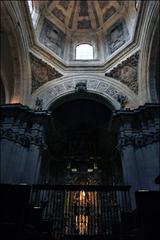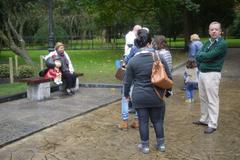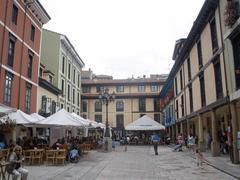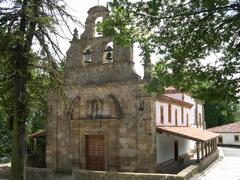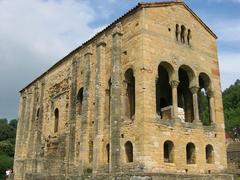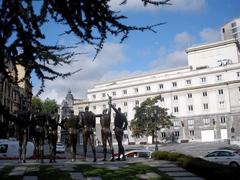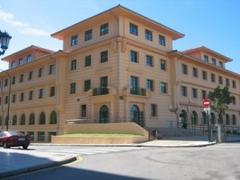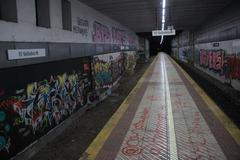
Monastery of San Pelayo Oviedo: Visiting Hours, Tickets, and Historical Significance
Date: 04/07/2025
Introduction
Located in the heart of Oviedo, Spain, the Monastery of San Pelayo (Monasterio de San Pelayo) is a cornerstone of Asturian religious and cultural history. Founded during the early Middle Ages under King Alfonso II of Asturias, this Benedictine convent has been a beacon of spiritual devotion, architectural transformation, and cultural preservation for over a millennium. Renowned for acquiring the relics of Saint Pelagius in 994 CE, the monastery became a significant pilgrimage site along the Camino de Santiago, shaping Oviedo’s spiritual identity and attracting visitors from across Europe (SpottingHistory; Wikipedia).
This guide provides essential information for travelers and pilgrims, including visiting hours, ticketing, accessibility, and travel tips. It also explores the monastery’s historical legacy, architectural features, artistic treasures, and ongoing role within Oviedo’s religious life. Whether you are drawn by faith, history, art, or curiosity, the Monastery of San Pelayo offers a uniquely enriching experience in northern Spain (Petit Futé).
Historical Overview
Foundation and Early History
The Monastery of San Pelayo was established in the 9th century under King Alfonso II of Asturias, a key figure in consolidating Christian rule and shaping the region’s religious landscape. Initially dedicated to Saint John the Baptist, the monastery’s location beside the Cathedral of Oviedo emphasized its spiritual and civic significance (SpottingHistory).
Acquisition of Relics and Pilgrimage
In 994 CE, the monastery was rededicated to Saint Pelagius after receiving his relics, transforming the site into a prominent pilgrimage stop on the Camino de Santiago. Saint Pelagius, a young Christian martyr from Córdoba, inspired devotion and pilgrimage, cementing the monastery’s reputation throughout northern Spain (Wikipedia).
Architectural Development
The original Romanesque structure underwent significant changes in the late 16th and 17th centuries. Architect Leonardo de la Cajiga redesigned the church in 1590, introducing Renaissance and Baroque elements. The current church, completed between 1592 and 1600, features a simple single-nave floor plan, an austere façade with three doors, and a niche above the main entrance housing a stone figure of San Pelayo. The cloister, the oldest surviving element, and the Baroque vicarage with Tuscan columns and ornate balconies, highlight the site’s architectural evolution (turismoasturias.es).
Benedictine Community and Living Tradition
For over a thousand years, the monastery has been home to a community of Benedictine nuns. Adhering to the Rule of Saint Benedict, the nuns emphasize prayer, work, and hospitality. Their daily life, centered around the Divine Office and the production of traditional baked goods, preserves monastic customs and sacred music, including Gregorian chant (The Travel Tester).
Artistic and Archival Heritage
The monastery’s church houses 16th-century choir stalls transferred from the old convent of San Vicente, featuring intricate wooden carvings of kings and emperors. The archives contain valuable manuscripts and collections from other monastic institutions, making the monastery a resource for historical research and artistic appreciation (turismoasturias.es).
Visiting the Monastery of San Pelayo
Visiting Hours
The Monastery of San Pelayo generally welcomes visitors:
- Tuesday to Saturday: 10:00 AM – 1:00 PM and 4:00 PM – 7:00 PM
- Sunday and Monday: Closed
- Note: Hours may vary on religious holidays; visitors are advised to confirm via the official website or the Oviedo Tourist Office.
Tickets and Admission
- Admission: Free entry to the monastery; donations are appreciated.
- Guided Tours: By prior appointment, guided tours can be arranged for deeper insight into the monastery’s history and art. Contact the monastery or the Oviedo Tourist Office to book.
Accessibility
- The monastery is centrally located and accessible on foot from Oviedo’s main attractions.
- Some areas, such as the cloister and church, are accessible via ramps, but historic features may limit full accessibility. It is recommended to inquire in advance about specific needs.
Guided Visits and Hospitality
While interior access is generally limited due to the cloistered nature of the convent, guided walking tours of Oviedo’s historic center often include the monastery’s exterior and its story. The Benedictine community also offers hospitality through their guesthouse (hospedería), which includes modern amenities and is available for personal retreats, study days, and small events (sanpelayomonasterio.org).
Participation in Religious Life
Visitors may join in liturgical services and experience the spiritual life of the Benedictine community, particularly during special feasts such as those of San Pelayo and Saints Peter and Paul.
Nearby Attractions in Oviedo
- Cathedral of Oviedo (San Salvador): An iconic Gothic cathedral and major pilgrimage destination.
- Asturias Archaeological Museum: Located in the former San Vicente Monastery, showcasing Asturian history.
- Museum of Fine Arts of Asturias: Features art from the Middle Ages to the present.
- Pre-Romanesque Churches on Mount Naranco: Santa María del Naranco and San Miguel de Lillo, UNESCO World Heritage Sites.
- Plaza del Fontán: A vibrant square with markets and cafés.
- Historic Palaces: Including the Palace of the Marquis de Santa Cruz del Marcenado and Palace of the Count of Toreno (spain.info).
All these attractions are within walking distance, making the monastery an ideal starting point for exploring Oviedo’s heritage.
Pilgrimage and the Camino de Santiago
Positioned along the historic Camino Primitivo, the monastery has provided shelter and spiritual support to pilgrims for centuries. The relics of Saint Pelagius and the welcoming Benedictine community continue to draw those on a spiritual journey (The Travel Tester).
Visitor Tips and Practical Information
- Dress Code: Modest attire is requested when visiting religious sites.
- Etiquette: Silence and respect for the cloistered environment are essential, particularly during services.
- Donations and Shop: Support the monastery by making a donation or purchasing traditional baked goods crafted by the nuns.
- Plan Ahead: Confirm opening hours and tour availability in advance, especially during holidays or special events.
- Language: Spanish is primarily spoken, with English available for guided tours upon request.
- Safety: Oviedo is a safe city with a welcoming atmosphere for visitors of all backgrounds.
Frequently Asked Questions (FAQs)
Q: Is the Monastery of San Pelayo open to the public?
A: The monastery is an active cloistered convent; interior visits are limited, but guided tours and participation in services may be available by arrangement.
Q: What are the visiting hours?
A: Generally, Tuesday to Saturday from 10:00 AM to 1:00 PM and 4:00 PM to 7:00 PM. Closed Sundays and Mondays. Check the official website for updates.
Q: Is there an entrance fee?
A: Admission is free; donations are welcome.
Q: Are guided tours available?
A: Yes, by prior appointment through the monastery or the Oviedo Tourist Office.
Q: Is the monastery accessible to those with mobility impairments?
A: Some areas are accessible, but due to historic architecture, full accessibility may be limited.
Q: Can I purchase goods made by the nuns?
A: Yes, the monastery shop sells traditional baked goods to support the community.
Visuals and Resources
- Images: Include photographs of the monastery’s façade, cloisters, and interior choir stalls with descriptive alt text such as “Monastery of San Pelayo exterior in Oviedo” and “Choir stalls at Monastery of San Pelayo.”
- Maps: Interactive maps and virtual tours are available on the Oviedo Tourist Office and monastery websites.
Further Exploration
- [Oviedo Cathedral: History and Visitor Guide]
- [Top Attractions in Oviedo]
- [Camino de Santiago: Pilgrimage Routes and Tips]
Conclusion
The Monastery of San Pelayo stands as a living testament to Oviedo’s enduring spiritual and cultural heritage. Its remarkable history, architectural beauty, and active Benedictine community offer visitors a rare window into the city’s medieval roots and Christian traditions. Whether you are a pilgrim, a history lover, or a curious traveler, a visit to San Pelayo provides inspiration and a sense of connection to centuries of faith and resilience.
For up-to-date information, guided tours, and personalized travel guides, visit the official monastery website, the Oviedo Tourist Office, or download the Audiala app. Supporting the monastery—through donations or purchases—helps preserve this unique landmark for future generations.
Sources and External Links
- Monastery of Saint Pelagius - Spotting History
- Monastery of San Pelayo Visiting Hours, Tickets, and Historical Guide | Oviedo’s Religious Landmark - The Travel Tester
- Visiting the Monastery of San Pelayo in Oviedo: Hours, Tickets, and Historical Insights - Turismo Asturias
- Visiting the Monastery of San Pelayo and Exploring Oviedo’s Historical Sites - Petit Futé & The Tourist Checklist
- Official Monastery Website
- Wikipedia: Monastery of Saint Pelagius
- Spain.info: Monastery San Pelayo






